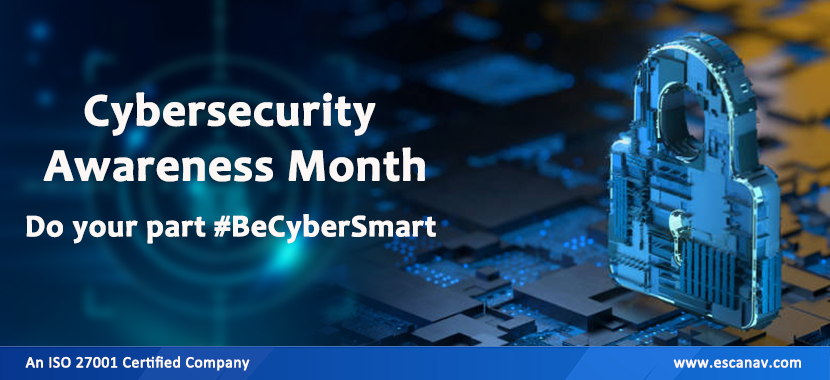October has arrived, which means it’s Cyber Security Awareness Month. It’s that time of year again when we need to remember and recommit to raising awareness about the threats and risks posed by malicious digital activities.
Cybercriminals don’t care if it’s Halloween or any other holiday; they continue to haunt the darkest corners of the internet. This is why it is critical to remain vigilant against threats and to be aware of the cyber security landscape.
National Cyber Security Awareness Month, now known as Cyber Security Awareness Month, was established in 2003. The Cyber Security and Infrastructure Security Agency (CISA) and the National Cyber Security Alliance (NCSA) launched this effort to raise awareness about the importance of cyber security and to assist people in staying safer and more secure online. Both CISA and NCSA have pushed enterprises and people to take proactive actions to improve cyber security during the previous 18 years.
Following their good work, our internal experts suggest the following points to observe and to maintain a high level of cyber security awareness.
The emphasis should be on Cyber Innovation
Organizations must prioritize cyber innovation at a time when adversaries are constantly updating their tactics, methods, and procedures (TTPs) to launch sophisticated attacks. They must think outside the box and use technology-driven solutions to streamline their cyber security operations and remedy gaps in their security postures.
It is time to consider next-generation technologies such as the Virtual Cyber Fusion Center (vCFC), which combines threat intelligence with security orchestration, automation, and response (SOAR), eliminating security team silos and driving collaboration and threat visibility across your security apparatus. This type of technology enables your security staff to regularly gauge and calibrate their strategies based on the prevalent threat ecosystem.
You must upgrade your security architecture to vCFC if you want to boost threat visibility and response capabilities. This approach combines many security functions on a single platform to improve collaboration among siloed security teams. However, it also includes SOAR features that allow you to develop automated, cross-functional processes that can orchestrate security and response operations across several deployment scenarios. You may swiftly respond to threats and reduce the time spent on manual processes by utilizing a vCFC’s next-generation SOAR capability.
Threat Intel Sharing Is Encouraged
Threats continue to change, even as cyber security specialists attempt to strengthen their security posture. In such instances, if one business detects a threat, its peers can learn from the incident and avoid being impacted. This can only happen if threat intelligence is shared.
As an organization, you must adopt and encourage threat intelligence sharing with your sectoral peers, members of the information-sharing community, vendors, and other stakeholders with similar security interests, as it drives contextual threat visibility and the ability to transmit, receive, and access threat information in real-time. This will boost their ability to perceive, grasp, and respond to digital hazards more swiftly.
Sharing makes threat intelligence more accessible and operational, extending each participating organization’s understanding of assets, adversaries, indications of compromise (IOCs), TTPs, and other topics. It enhances awareness of incidents as they occur and aids in reducing response time. Furthermore, enterprises must use advanced threat intelligence platforms (TIPs) to enrich and contextualize threat information ingested in real-time from many reliable sources.
Response To Threats Should Be Taken Seriously
Most organizations define incident response as event containment. They may now move beyond incident response and focus on threat response, which encompasses more significant areas of the threat domain such as vulnerabilities, malware, and threat actors, thanks to new technologies.
Modern-day threat response platforms must be used by organizations to assist them to draw the dots between various incidents and threats. These systems can power security operations by utilizing real-time threat intelligence as well as security orchestration and automation processes. This will enable security teams to deal with risks before they become cyberattacks.
Enhance Collective Defense
The emergence of sophisticated and nation-state threat actors continues to attack both the government and private companies. The traditional approach to cyber security is inadequate in such a complex threat scenario. You must employ a collective defense strategy to encourage collaboration among your peer companies through threat intelligence sharing and threat response against advanced threats. Because of its capacity to draw the dots between multiple threat factors, vCFCs enable you to fuel collective defense through a single integrated and flexible platform-based solution and supports you in making better incident-response decisions.
Situational Awareness Should Be Maintained
You should strive for 24×7 situational awareness in your business by providing real-time threat alerts to your security teams and employees based on their role and location. This will help them better grasp the threats they face, improve their day-to-day security, business, or operational decisions, and emphasize the importance of cyber security to the entire organization.
Bare in mind
Beware! Cybercriminals do not require a license to hack. You must be proactive in order to defend your organization.
Not only in October, but all year long, you must be aware of developing cyber security dangers and learn how to defend against them. Furthermore, you should assist your stakeholders and colleagues in understanding how to stay on top of threats and use the best cyber security policies to defend them online.
To read more, please check eScan Blog







